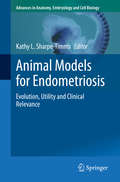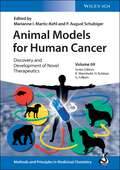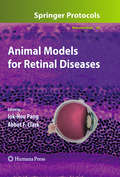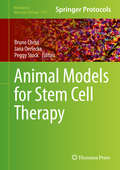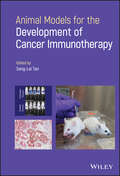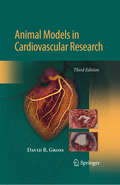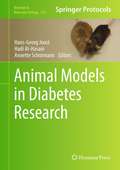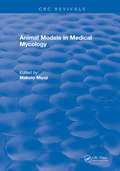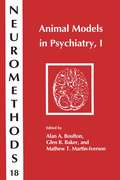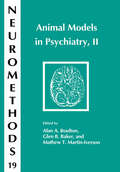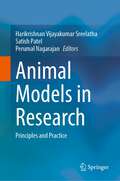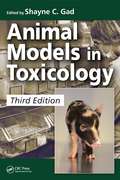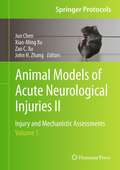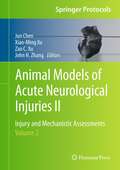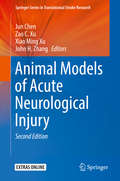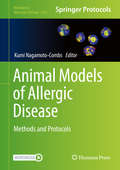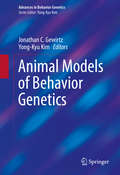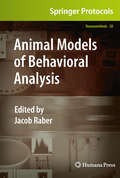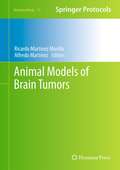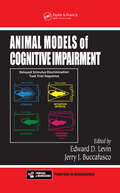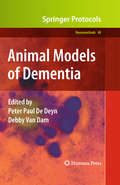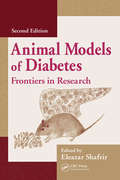- Table View
- List View
Animal Matters: Diary of an Inner City Vet
by Charlotte ReaAnimals bond people and transcend class, financial and cultural barriers, pets matter to people more than anything, but what happens to those people who can't afford pet insurance or vet's bills.Animal Matters is a diary of real-life cases written during a year of Charlotte's career working as a veterinary surgeon in a 24-hour inner-city London animal charity hospital. The book provides readers with a revealing, honest, emotional experience, with deeply sad moments followed by amusing and unimaginable ones. Charlotte writes both short amusing diary entries along with more detailed accounts and reflections back on her training and the experiences and difficulties she has come up against over the decade since she graduated. Throughout the book you will get to know both the animals and the people and how close the bond between us can be. Charlotte also discusses contemporary issues in veterinary medicine such as animal euthanasia, RSPCA welfare cases, mental health issues within the veterinary profession, ethical concerns around pedigree dog breeding and the laws on dangerous dogs. Animal Matters is a moving and heartwarming book about the unconditional love between animals and humans, and how deep the bond can be.(P)2019 Hodder & Stoughton Limited
Animal Models for Endometriosis: Evolution, Utility and Clinical Relevance (Advances in Anatomy, Embryology and Cell Biology #232)
by Kathy L. Sharpe-TimmsThis new volume of our successful book series Advances in Anatomy, Embryology and Cell Biology focuses on the need for and use of animal models when studying endometriosis. Covering models ranging from rodents to baboons, it explores novel mechanisms involved in the pathophysiology of endometriosis. Topics range from the role of miRNAs and environmental endocrine disrupters to pain and endometriosis-associated subfertility.Estimated to affect up to 10% of women, endometriosis is a widespread and in some cases debilitating disease. While studies on the pathophysiology of the disease and the development of treatments for endometriosis-associated subfertility are called for, acquiring appropriate tissues from women with and without endometriosis in combination with physiologically relevant in vitro and in vivo laboratory models is an essential aspect. However, control subjects with similar ages, living environments and medical histories, besides endometriosis, are hard to find and attaining suitable human reproductive tissues is linked to an ongoing ethical discussion, especially when studying embryos. Laboratory models like rodent and monkey models are therefore needed to fill the research gap and support hypothesis-driven, randomized, controlled experimental design studies. In this book we highlight the latest developments and findings in endometriosis research using animal models. The book was written for scientists, physicians and medical students working in the field of reproductive science, and for women with endometriosis.
Animal Models for Human Cancer: Discovery and Development of Novel Therapeutics
by Raimund Mannhold Gerd Folkers Hugo Kubinyi Marianne I. Martic-Kehl Pius August SchubigerBased on results from the past ten years, this ready reference systematically describes how to prepare, carry out, and evaluate animal studies for cancer therapies, addressing the widely recognized lack of reliable and reproducible results. Following a short historical introduction and a discussion of the ethics surrounding animal experiments, the book describes correct study design as well as the handling and housing of animals. It then goes on to describe the animal models available for different cancer types, from natural cancer models in mice and dogs to humanized animals. An evaluation of previously unpublished long-term data from the Swiss canine and feline cancer registry is also included. The final part of the book reviews the lessons learned over the last decade on how to interpret data from animal studies for improving human therapy and gives recommendations for future drug development.
Animal Models for Retinal Diseases (Neuromethods #46)
by Iok-Hou Pang Abbot F. ClarkAffecting over a hundred million individuals worldwide, retinal diseases are among the leading causes of irreversible visual impairment and blindness, and appropriate study models, especially animal models, are essential to furthering our understanding of the etiology, pathology, and progression of these endemic diseases. In Animal Models for Retinal Diseases, recognized experts in the field highlight valuable techniques as well as animal models for the prominent retinal diseases in order to aid in the evaluation, development, and improvement of therapeutic strategies. Beginning with an overview of the morphology of the retina, visual behavior, and genetics and genomics approaches for retinal research, the book continues by covering animal models for the research of specific human retinal diseases, e.g., retinal degeneration, age-related macular degeneration, retinopathy of prematurity, diabetic retinopathy, glaucoma, retinal ischemia, and retinal inflammation. As a volume in the successful Neuromethods series, the chapters provide authoritative reviews of the most commonly used approaches in the field. Vital and easy to use, Animal Models for Retinal Diseases serves to support the important future research of ocular investigators, ophthalmologists, and neuroscientists currently delving into this fascinating field of study.
Animal Models for Stem Cell Therapy (Methods in Molecular Biology #1213)
by Bruno Christ Jana Oerlecke Peggy StockIn Animal Models for Stem Cell Therapy: Methods and Protocols, expert researchers in the field detail disease models of hepatic, cardiovascular, neurological diseases, connective and contractile tissue. Chapters focus on a wide range of diseases and application of different kinds of stem cells and reprogrammed tissue cells (iPS). Written in the highly successful Methods in Molecular Biology series format, chapters include introductions to their respective topics, lists of the necessary materials and reagents, step-by-step, readily reproducible laboratory protocols and key tips on troubleshooting and avoiding known pitfalls. Authoritative and practical, Animal Models for Stem Cell Therapy: Methods and Protocols, covers interest of basic scientists and clinicians to assess the biological as well as the therapeutic potential of stem cell therapy.
Animal Models for the Development of Cancer Immunotherapy
by Seng-Lai TanAnimal Models for the Development of Cancer Immunotherapy Provides readers with a clear understanding of the value and challenges of using common and emerging preclinical models in cancer immunotherapy research and development. Animal models are essential tools for studying a range of issues in preclinical and clinical research on therapies targeting cancerous tumors. As clinical trials of advances in cancer immunotherapy are predicted to outpace preclinical research in the near future, there remains an urgent need to develop better animal models for preclinical evaluation of novel modulators. Animal Models for the Development of Cancer Immunotherapy provides a detailed overview of different preclinical model systems for development of novel cancer immunotherapies while highlighting how key aspects of individual models translate into clinical findings. Covering the introduction, development, and therapeutic applications of animal models for cancer immunotherapy, this comprehensive volume helps pharmacologists identify suitable animal models, design pharmacological or translational studies, and advance their mechanistic understanding of therapeutic agents, and increase the possibility of success for novel immunotherapies in clinical settings. Chapters written by prominent leaders in the field address specific models that evaluate immuno-oncology drugs are supported by in-depth case studies and extensive references throughout. Emphasizes the importance of modeling tumor metastasis in preclinical models for efficient translation of findings into the clinic Explores recently discovered mechanisms of resistance and their preclinical modeling Highlights the unique characteristics and features of autologous and allogeneic approaches for humanization of mouse models Reviews development of bone marrow-liver-thymus (BLT) immune humanized mice and emerging alternative models such as genetically engineered mouse models (GEMM) Discusses alternative animal models for cancer research such as severe combined immunodeficiency (SCID) pigs Animal Models for the Development of Cancer Immunotherapy is an essential resource for scientists and researchers in the pharmaceutical and biotechnology industries, medicinal chemists and biochemists, cell and molecular biologists, pharmacologists, immunologists, and clinicians.
Animal Models in Cardiovascular Research (Developments In Cardiovascular Medicine Ser. #Vol. 153)
by David GrossInterest in the humane and scientifically justifiable use of research animals has intensified since the publication of the 2nd edition of Animal Models in Cardiovascular Research. This completely revised and updated edition will provide information essential to any researcher interested in using animal models for cardiovascular research, or any research which requires normal cardiovascular function. The format and presentation will be changed to make the text more easy to read and use: (1) This edition is in outline format, for ease and utility. (2) The opening chapter includes more information on the cardiovascular effects of post-operative analgesia and will address the recognition of pain behavior in species commonly used in research settings, particularly rats and mice. (3) New edition includes reference material more useful to researchers using transgenic and naturally occurring animal models to dissect these mechanisms.
Animal Models in Diabetes Research (Methods in Molecular Biology #933)
by Hadi Al-Hasani Annette Schürmann Hans-Georg JoostIn recent years, human studies have made enormous contributions towards an understanding of the genetic basis of diabetes mellitus; however, most of the experimentation needed for the invention and testing of novel therapeutic approaches cannot be performed in humans. Thus, there is no alternative to appropriate animal models. In Animal Models in Diabetes Research, expert researchers explore the current status of the most important models and procedures in order to provide a timely resource in experimental diabetology. The first half of the volume serves as a comprehensive overview on our current knowledge of the pathogenesis and pathophysiology of diabetes in animal models through a series of reviews in model strains. The book then continues with vital, established protocols that are employed in the characterization and study of animal models of diabetes. As a volume in the highly successful Methods in Molecular BiologyTM series, this work contains the type of detailed description and key implementation advice necessary to achieve successful results. Authoritative and cutting-edge, Animal Models in Diabetes Research delivers essential content that will be an important resource to advance diabetes research in the years to come.
Animal Models in Medical Mycology
by Makoto MiyajiThe prevalence of antibiotics, corticosteroids, and anticancer or immunosuppressive drugs and the progress of the medical treatments after World War II have saved the lives of many patients attacked by serious diseases and have contributed to the prolongation of the average life span of a human being. However, there still remain some problems to be solved. One of them is that of compromised hosts, which will be treated in this book.
Animal Models in Orthopaedic Research
by Yuehuei H. An Richard J. FriedmanAnimal Models in Orthopaedic Research is a reference book of the major animal models used in the study of orthopaedic conditions and in the in vivo study of biomaterials. Use of animal models provides important knowledge about pathological conditions that can eventually lead to the development of more effective clinical treatment of diseases in bot
Animal Models in Psychiatry, I (Neuromethods #18)
by Alan A. Boulton Glen B. Baker Mathew T. Martin-IversonThe wealth of material presented in Animal Models in Psychiatry has necessitated its expansion into a comprehensive, two-volume work. <P><P> This initial volume opens with an introductory chapter on criteria for assessing the validity of animal models in psychiatry, providing a framework in which to evaluate subsequent chapters in both volumes. Chapters are devoted to specific psychiatric disorders, along with various procedures that have been proposed as potential animal models for understanding their etiology and management. <P> Contributors are renowned experts in their respective fields, and bring to light new insight into several animal models including: <P> * parallels to schizophrenia <P> * hippocampal lesions and schizophrenia <P> * stimulant psychoses <P>* hallucinations and continuous stimulants <P>* mania <P>* tardive dyskinesia <P>* activity anorexia <P>* attention deficit <P>* neuroleptic-induced oral dyskinesias. <P> Everyone involved in psychiatric research, general neuroscience, and a host of other disciplines will find Boulton, Baker, and Martin-Iverson's timely new volume an indispensable resource for both office and laboratory.
Animal Models in Psychiatry, II (Neuromethods #19)
by Alan A. Boulton Glen B. Baker Mathew T. Martin-IversonThe wealth of material presented in Animal Models in Psychiatry has necessitated its expansion into a comprehensive, two-volume work. <P><P> This initial volume opens with an introductory chapter on criteria for assessing the validity of animal models in psychiatry, providing a framework in which to evaluate subsequent chapters in both volumes. Chapters are devoted to specific psychiatric disorders, along with various procedures that have been proposed as potential animal models for understanding their etiology and management. <P> Contributors are renowned experts in their respective fields, and bring to light new insight into several animal models including: <P> * parallels to schizophrenia <P> * hippocampal lesions and schizophrenia <P> * stimulant psychoses <P> * hallucinations and continuous stimulants <P> * mania <P> * tardive dyskinesia <P> * activity anorexia <P> * attention deficit <P> * neuroleptic-induced oral dyskinesias.<P> Everyone involved in psychiatric research, general neuroscience, and a host of other disciplines will find Boulton, Baker, and Martin-Iverson's timely new volume an indispensable resource for both office and laboratory.
Animal Models in Research: Principles and Practice
by Harikrishnan Vijayakumar Sreelatha Satish Patel Perumal NagarajanThis book describes the development of animal models widely used in biomedical research using step-wise instructions and photographs. Showcasing a wide range of species from zebra fishes, birds, rodents, rabbits, dogs, and pigs, the book includes detailed methodology on how to work with these species and to develop various models. The animal models in neurology including stroke, Alzheimer’s disease, Parkinson’s disease, and Schizophrenia; Animal models in cancer research, sleep disorders, and cardiovascular diseases are described to meet the understanding of researchers who plan to replicate these models in their laboratories. In depth detailing on the development of targeted gene knockouts and transgenics, implantation models that are used in toxicology studies, and pharmacokinetic studies in pigs and dogs are a highlight. Further, the book describes pharmacologic, chemically induced, surgically induced, microbiologically induced, infectious models, models for neurobehavioral studies, oncology research, and pain research. The book has dedicated sections on anesthesia and analgesia and teaches procedures like venous cut-downs and cannulations in pigs and dogs, and endotracheal intubation, mechanical ventilation and thoracotomy in rodents and will serve as a self-training tool. Concepts in the field of animal model development are explained using examples. Sample size selection, study design, and statistical evaluation of experiments involving laboratory animals are explained to enable young researchers to practically understand the nuances. This book will be a valuable tool for academicians, students, scientists, and veterinarians and will benefit equally who are new to the field and who are already working with laboratory animals.
Animal Models in Toxicology
by Shayne Cox GadAnimal Models in Toxicology is a single-source reference for the use of animal models in toxicology. Chapters cover nine species used in toxicology and experimental biology. With contributions from experts in toxicology, toxicological pathology, and species-specific metabolism, each of these chapters provides an excellent introductory "course" alon
Animal Models of Acute Neurological Injuries II: Injury and Mechanistic Assessments, Volume 1 (Springer Protocols Handbooks)
by John H. Zhang Zao C. Xu Jun Chen Xiao-Ming XuThe successful previous volume on this topic provided a detailed benchwork manual for the most commonly used animal models of acute neurological injuries including cerebral ischemia, hemorrhage, vasospasm, and traumatic brain and spinal cord injuries. <P><P> Animal Models of Acute Neurological Injuries II: Injury and Mechanistic Assessments aims to collect chapters on assessing these disorders from cells and molecules to behavior and imaging. These comprehensive assessments are the key for understanding disease mechanisms as well as developing novel therapeutic strategies to ameliorate or even prevent damages to the nervous system. <P><P> Volume 1 examines general assessments in morphology, physiology, biochemistry and molecular biology, neurobehavior, and neuroimaging, as well as extensive sections on subarachnoid hemorrhage, cerebral vasospasm, and intracerebral hemorrhage. Designed to provide both expert guidance and step-by-step procedures, chapters serve to increase understanding in what, why, when, where, and how a particular assessment is used.<P><P> Accessible and essential, Animal Models of Acute Neurological Injuries II: Injury and Mechanistic Assessments will be useful for trainees or beginners in their assessments of acute neurological injuries, for experienced scientists from other research fields who are interested in either switching fields or exploring new opportunities, and for established scientists within the field who wish to employ new assessments.
Animal Models of Acute Neurological Injuries II: Injury and Mechanistic Assessments, Volume 2 (Springer Protocols Handbooks)
by John H. Zhang Zao C. Xu Jun Chen Xiao-Ming XuThe successful previous volume on this topic provided a detailed benchwork manual for the most commonly used animal models of acute neurological injuries including cerebral ischemia, hemorrhage, vasospasm, and traumatic brain and spinal cord injuries. Animal Models of Acute Neurological Injuries II: Injury and Mechanistic Assessments aims to collect chapters on assessing these disorders from cells and molecules to behavior and imaging. These comprehensive assessments are the key for understanding disease mechanisms as well as developing novel therapeutic strategies to ameliorate or even prevent damages to the nervous system. Volume 2 examines global cerebral ischemia, focal cerebral ischemia, and neonatal hypoxia-ischemia, as well as intensive sections covering traumatic brain injury and spinal cord injury. Designed to provide both expert guidance and step-by-step procedures, chapters serve to increase understanding in what, why, when, where, and how a particular assessment is used. Accessible and essential, Animal Models of Acute Neurological Injuries II: Injury and Mechanistic Assessments will be useful for trainees or beginners in their assessments of acute neurological injuries, for experienced scientists from other research fields who are interested in either switching fields or exploring new opportunities, and for established scientists within the field who wish to employ new assessments.
Animal Models of Acute Neurological Injury: Injury And Mechanistic Assessments, Volume 1 (Springer Series in Translational Stroke Research)
by John H. Zhang Zao C. Xu Jun Chen Xiao Ming XuDespite numerous recent studies and exciting discoveries in the field, only limited treatments are available today for the victims of acute brain and spinal cord injuries. Animal Models of Acute Neurological Injuries, Second Edition, provides a standardized methodology manual designed to eliminate the inconsistent preparations and variability that often inhibit advances in this specialized research field. In the 10 years since publication of the first edition of this book, some animal models have become obsolete, some have stood the test of time, and newer models have emerged to enhance our knowledge of acute neurological injuries. The second edition continues to offer the research community tested approaches for this area of investigation.As with the first edition, top experts have developed and contributed these animal models. The book’s focus remains hands-on, practical applications of the models, rather than a theoretical approach. Each chapter contains a proven procedure enhanced by clear figures, illustrations, or videos. This new edition presents its readily reproducible protocols with clarity and consistency to best aid neuroscientists and neurobiologists. As with the first edition, the second edition is comprehensive and cutting-edge. Animal Models of Acute Neurological Injuries, Second Edition, is an ideal guide for research professionals, at all stages of their careers, who wish to pursue this vital course of study with the proficiency and precision required by the field.
Animal Models of Allergic Disease: Methods and Protocols (Methods in Molecular Biology #2223)
by Kumi Nagamoto-CombsThis volume provides protocols for mouse models of allergic diseases and guidelines for choosing a particular strains, allergen, adjuvant, and route of sensitization. Chapters detail types of allergic disease, methods that are frequently employed to analyze pathophysiology of allergic diseases, manipulation of intestinal microbiota, and desensitization of immure responses in animal models. Written in the highly successful Methods in Molecular Biology series format, chapters include introductions to their respective topics, lists of the necessary materials and reagents, step-by-step, readily reproducible laboratory protocols, and tips on troubleshooting and avoiding known pitfalls. Authoritative and cutting-edge, Animal Models of Allergic Disease: Methods and Protocols aims to offer a comprehensive collection of protocols and experience-derived instructions to further allergic disease research.
Animal Models of Behavior Genetics (Advances in Behavior Genetics)
by Jonathan C. Gewirtz Yong-Kyu KimThis stimulating analysis reviews the broad potential of animal models to foster a deeper understanding of human pathology, strengthen connections between genetic and behavioral studies, and develop more effective treatments for mental disorders. Widely-studied and lesser-used species are examined in models that capture features along the continuum of normative and pathological behavior. The models highlight genetic causes of core features, or endophenotypes, of developmental, internalizing, and externalizing disorders, as well as dementia. Expert contributors address questions ranging from how suitable species are chosen for study to the costs and benefits of using inbred versus outbred strains, and the effects of housing environment on subject animals. Larger issues addressed include how to evaluate the applicability of animal behavioral models to the human condition and how these models can harness emerging molecular technologies to further our understanding of the genetic basis of mental illness. Included in the coverage: Mating and fighting in Drosophila. Attachment and social bonding. Impulsivity in rodents and humans. Animal models of cognitive decline. Animal models of social cognition. Future directions for animal models in behavioral genetics. A detailed map of where this evolving field is headed, Animal Models of Behavior Genetics shows geneticists, molecular biologists, and cognitive neuroscientists paths beyond established concepts toward a more knowledgeable and collaborative future.
Animal Models of Behavioral Analysis (Neuromethods #50)
by Jacob RaberDespite the difficulty in comparing clinic-based human tests with animal model testing, there is still great value in pursuing translational approaches, as tests and treatment strategies might be developed to improve brain function in humans suffering from neurological conditions and knowledge obtained from human behavioral studies can be used to further improve the animal models of behavioral analysis. In Animal Models of Behavioral Analysis, expert neuroscientists focus on approaches to translate and compare behavioral tests used in animals with those used in humans not only to increase our understanding of brain function across species but also to provide objective performance measures and bridge the gap between behavioral alterations in humans with cognitive disorders and the correlating animal models of these conditions. Written in the Neuromethods series format, the chapters provide authoritative reviews of many commonly used approaches in the field today. Provocative and cutting-edge, Animal Models of Behavioral Analysis seeks to aid researchers in further developing these vital techniques in an effort to advance studies in both the clinic and the laboratory.
Animal Models of Brain Tumors (Neuromethods #77)
by Alfredo Martínez Ricardo Martínez MurilloAlthough the available models, whether at the cellular, tissue, or animal level, do not exactly represent the biology of human brain tumors, animal models can offer significant insights into these tumors, providing a better understanding of biological mechanisms underlying tumor generation, growth, angiogenesis, invasion, and metastasis. Animal Models of Brain Tumors brings together developments and discoveries in "in vivo" experimental tumor research that have provided advances in our understanding of the cellular and molecular mechanisms involved in the generation, progression, and clinical outcome of brain neoplasms. Broken into convenient sections, this thorough volume includes topics such as animal model insights into human brain neoplasms, the cellular, molecular, and genetic basis of brain tumors, therapies in the treatment of malignant glioma, as well as imaging technologies in animal tumor models, i.e. measuring brain tumor growth and metabolism. Written for the popular Neuromethods series, chapters include the kind of detailed description and implementation advice that is essential for achieving successful results. Authoritative and cutting-edge, Animal Models of Brain Tumors provides the key methods needed to validate, compare, and contrast the animal model with its proposed human counterpart and further the understanding of our own serious ailments.
Animal Models of Cognitive Impairment
by Edward D. Levin Jerry J. BuccafuscoThe costs associated with a drug's clinical trials are so significant that it has become necessary to validate both its safety and efficacy in animal models prior to the continued study of the drug in humans.Featuring contributions from distinguished researchers in the field of cognitive therapy research, Animal Models of Cognitive Impairmen
Animal Models of Dementia (Neuromethods #48)
by Peter Paul De Deyn Debby Van DamWith an ever-increasing elderly population and the resultant rising levels of dementia-related disorders, preclinical research based on animal models is pivotal to our knowledge of underlying molecular mechanisms and drug discovery aiming at the development of therapeutic strategies alleviating or preventing the neurological devastation. In Animal Models of Dementia, expert researchers provide contributions that stress the importance of extensively validated animal models in drug discovery and development in order to predict clinical activity. Beginning with general aspects of animal modeling, related ethical issues, and essential methodological considerations, the highly detailed volume then continues with various levels of model validation, including pathological, behavioral, neurochemical, pharmacological, and imaging aspects, followed by sections focused on specific disorders, such as Alzheimer's disease, Parkinson's disease, metachromatic leukodystrophy and adrenoleukodystrophy, amyotrophic lateral sclerosis, frontotemporal dementia as well as vascular dementia and more. As a volume in the renowned Neuromethods series, this book offers a detailed, yet accessible, overview of currently available animal models in the field of dementia research, and touches, as well, upon more general areas linked to the development and use of animal models. Comprehensive and efficient, Animal Models of Dementia will significantly aid both experienced animal researchers as well as investigators on the verge of beginning animal model-based dementia research.
Animal Models of Diabetes: Frontiers in Research
by Eleazar ShafrirAs the incidence of diabetes increases worldwide, the need for recommendations on how to prevent and treat the condition grows exponentially, and so does the need for an authoritative source for information on the appropriate models to study the condition. The new edition of Animal Models of Diabetes is that source. The book presents updated
Animal Models of Drug Addiction (Neuromethods #24)
by Alan A. Boulton Glen B. Baker Peter H. WuA comprehensive guide to the use of animal models for understanding the many facets of drug and alcohol abuse-problems that are now worldwide health concerns. Expert investigators have contributed state-of-the-art chapters on the use of animal models for research on substance abuse.

